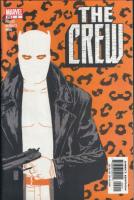
Black History Month ’09 #20: It Ain’t Hard To Tell
February 20th, 2009 Posted by david brothersG Willow Wilson and CAFU’s recently completed Vixen: Return of the Lion miniseries is an interesting little book. It’s not quite part of DC’s Year One initiative, where characters have their origins revamped and retold for a new audience. At the same time, it isn’t quite something like Huntress/Question: Cry for Blood, where an already established character is just thrown at you with little to no context. It exists in this in-between state, since it re-introduces Vixen to readers of the DC Universe and firmly establishes her place in, for want of a better word, continuity. Marvel pushed out a similar miniseries a couple years ago called White Tiger, written by Tamora Pierce, Timothy Liebe, and drawn by Phil Briones. It wasn’t so successful, and I’ve got a few ideas why.
There are more than a few similarities between the two books. Both were written by women, with White Tiger being co-written by Pierce’s husband. Both spun out of events in Justice League of America or Daredevil, depending on the character. Where Vixen had to rediscover her center and learn new things about her powers, White Tiger had to figure out her heroic identity for the first time. The difference, and I think the largest part of why Return of the Lion is a successful story and White Tiger is not, is in the portrayal of the two heroines.
(As an aside– there is a tremendous difference in art in the two series. CAFU is a true talent, and draws people with distinctive faces, backgrounds, sizes, and so on. Vixen: Return of the Lion is one of the best-looking mainline DC Comics in ages. To put it bluntly… White Tiger isn’t. The art is uninspired, poorly laid out, and overall very dreary.)
One thing I love about G Willow Wilson is that she does research. The care she takes when writing shows in her work, as the fictionalized Africa that serves as the setting for Return of the Lion feels just as authentic as any story about real Africa. The people don’t speak in pidgin English. Instead, they talk like regular people. The cadence or rhythm of their speech may be different, but that’s a more skilled way to do accents than throwing in random words or phrases of “African.” Even the clothes and characters in the series, courtesy of artist CAFU, look great.
Pierce’s White Tiger is on the opposite side of the spectrum. A college-educated, veteran FBI agent, and grown woman falls back on Claremontian ways of showing just how foreign she is. “Estupido!” and “Puto!” abound in the series. I could buy the occasional “tio” or “tia,” as people tend to talk differently around family than they do in public, but when the Japanese characters show up, it’s pidgin Japanese and talk about honor and seppuku all over the place.
If you compare the two characters, White Tiger feels cheap. She’s a cardboard cutout, a Paper Puerto Rican. Setting aside how confused and directionless the series was, White Tiger, as a character, was weak overall. She never rings true on any level, except maybe “woman.” Vixen, on the other hand, feels much stronger. She’s focused, she reads as an experienced adult, and her personality comes through clear as a bell. Wilson has a very solid grasp of dialogue, and she gives Vixen the kind of personality that clearly portrays her as a tough person, but still human. When she is weak, she is weak for very specific reasons.
Vixen feels authentic, White Tiger doesn’t.
Writing black characters, or any characters, isn’t as simple as dropping in a few buzzwords, a backwards cap, and “yo.” Having the speech down is the first step, but that’s just surface level stuff. You need to have the structure of a firmly realized character to hang that surface level writing on in order to make someone worth reading.

